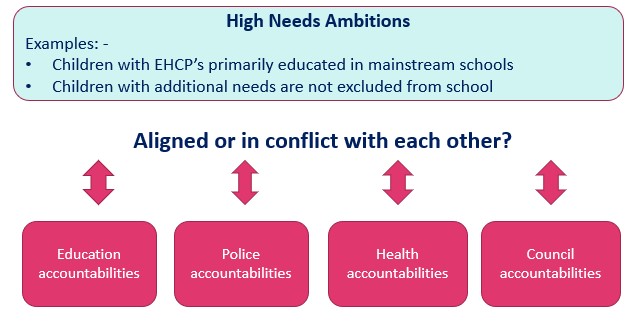At present, there is no nationally-defined outcomes framework for children with high needs or with special educational needs and disabilities (SEND). There is no mechanism for defining what ‘good’ looks like. There is no way of measuring what impact is being made through a significant financial investment in children and young people’s lives. Even the National Audit Office has expressed concern that the Department for Education is unable to quantify the impact of its support for pupils with SEND. Before demanding more funding, we therefore need to understand the value and impact that we are having with the funding already available.
Last week, we brought together a number of sector leaders with a range of backgrounds to discuss the challenges facing the High Needs system. The aim was to see whether we could define what ‘good’ looks like so that we can start to understand the value of all of the work, effort and resources currently going into supporting young people. We were fortunate to be joined by Dame Christine Lenehan as well as a number of Directors of Children’s Services, headteachers from primary, secondary and special schools, Clinical Commissioning Groups’ leads on SEND, and the National Parent Carer Forum. Our discussion was rich, wide-ranging and thought-provoking and also showed the complexity of measuring impact where every child with additional needs is different.
A number of themes emerged including:
- There is usually no overarching ambition or shared accountability across the High Needs system within a local area
- Those areas that have begun to set a joint vision have tended to have a more favourable Ofsted SEND inspection outcome
- While it seems obvious, we often forget that children with additional needs want to live as ordinary a life as possible and be included in the same things as their peers
- Current accountability frameworks are driving the wrong behaviours
This last point was particularly drawn out during our discussion. Participants believed that individual organisations’ accountabilities can conflict with a desire to have the right ambitions across a broader system for children with high needs that champions inclusion, early intervention and equal opportunities. For example, schools are accountable for – and are measured by success in – educational attainment rather than wider SEND or high needs ambitions.

At IMPOWER, we understand public services as a set of complex systems that public sector leaders have accountability for but not control of. One of the biggest challenges when working within any complex system is establishing limits or boundaries. The controllable system encompasses elements of the system where an individual public sector leader has direct command and control over staff, services and spending decisions. The influenceable system is chosen by the individual public sector leader and is the additional space in which they have practical influence over activities beyond the controllable boundary. Elements in the influenceable system might be in a different part of the organisation, in a different part of the public sector, in the wider community or just down the corridor from their own office.
The High Needs system has a small controllable space but a very wider influenceable space. Delivering effective support therefore requires the engagement and active participation of parents and carers, local schools, councillors, health colleagues, other departments within the council, voluntary and community services – the list goes on.
Getting the system working well is a particular challenge for leaders but there are huge opportunities if they can do so. The process should start with locking down a number of shared ambitions which, if delivered upon, would translate into better outcomes for children. The purpose of a local ‘ambitions framework’ should ultimately be to have readiness for a successful, fulfilling, independent adult life.
We will be reconvening as a group in the new year to draw up a set of ambitions that we think areas could commit to together in a local partnership. The additional funding recently announced for High Needs is an opportunity to change the focus, interventions and current approaches of the different agencies operating across the system.


